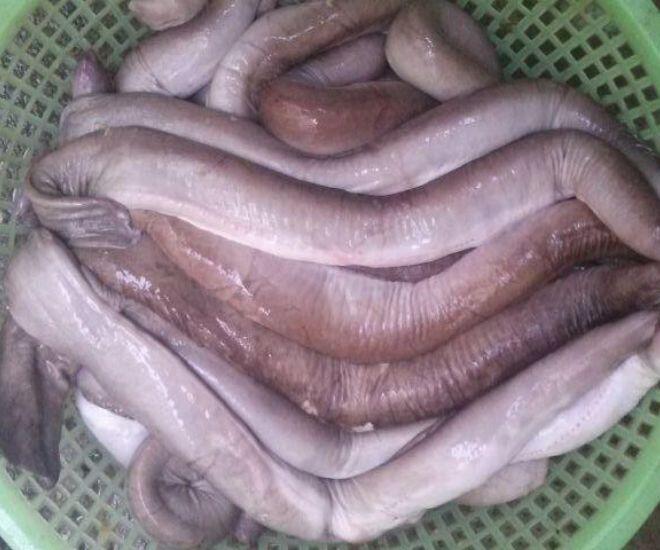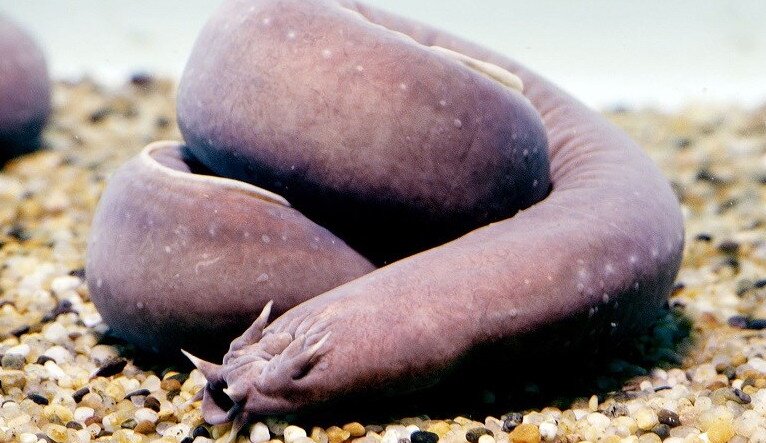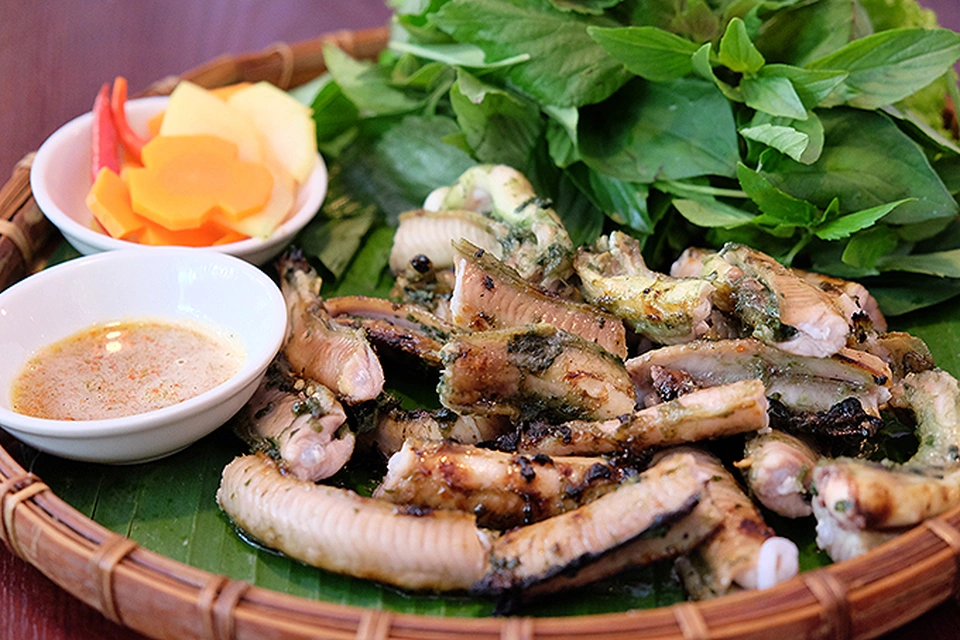
The Ninja Fish, also known as the Stone Sucker or Devil Fish, inhabits the depths of the ocean floor. Its appearance can be quite startling to those who see it for the first time: its body is slimy and eel-like, with a diameter of about 4 cm and a length of roughly two forearm lengths. Its head resembles that of a loach with short whiskers, and its eyes are so tiny that they are almost unnoticeable, leading some fishermen to describe them as “nearly blind.” The tail is fan-like, and the body is covered with circular pores that constantly secrete a mucus-like substance. The most notable feature, however, is the absence of a backbone; instead, it has a white cartilaginous core as fragile as tender ribs.
When caught, the Ninja Fish tends to curl up and hide its head, leading to the Vietnamese nickname “Ninja Fish,” reflecting its ability to appear and disappear swiftly, its camouflaging color, and its reclusive nature. Local fishermen in Binh Dinh, Vietnam, have given it this name.
According to local fishermen, this fish cannot be caught using conventional methods; instead, one must use a fishing rod or a drag net. They typically weigh between 300 and 500 grams each. There are two common varieties: the Black-backed Ninja Fish, with a dark back and white belly, usually found in shallow waters; and the Silky Ninja Fish, with a slender, elongated body and a light pinkish hue, dwelling at depths of around 1,000 meters and considered the more delicious of the two.

It was only about five years ago that the Ninja Fish began to gain popularity among diners in Vietnam. Prior to that, it was already well-known in South Korea and several European countries, where it was considered a delicacy. In Vietnam, its unique flavor has gradually made it a favorite among restaurants and pubs, especially in coastal cities in the central region.
At first glance, the Ninja Fish may seem unappetizing due to its slimy, snake-like appearance. However, once prepared, it captivates diners with its fragrant, sweet, and chewy flesh. The most notable difference from other fish is its meat’s resemblance to chicken in texture, while its cartilage is crisp and crunchy. Whether served as a beer snack or with plain rice, the Ninja Fish always leaves a strong impression.
Currently, fresh Ninja Fish sells for approximately 200,000–300,000 VND per kilogram, depending on the season. In addition to fresh fish, frozen and pre-processed Ninja Fish are also available online year-round and shipped nationwide.

Ninja Fish meat is considered versatile and suitable for a variety of palates. It can be grilled, fried, stir-fried, used in hot pots, or cooked in butter or tamarind sauce, and even in curry. The two most popular dishes are Grilled Ninja Fish with Salt and Chili and Braised Ninja Fish with Banana Blossoms and Tofu.
For the grilled dish, the fish is cleaned, skinned, cut into sections, and marinated in salt, chili sauce, and spices. It is then grilled over hot coals until it emits a mouthwatering aroma and the meat becomes firm. Served with fresh herbs or pickled vegetables, this dish offers a delightful combination of spicy and sweet flavors.
On the other hand, the braised dish showcases a more rustic flavor profile. The fish is cooked with green banana blossoms, fried tofu, fermented rice, turmeric, and various herbs. The chewy fish meat, combined with the thick, mildly sour broth and fragrant spices, has earned praise from discerning diners, some of whom prefer it to the more traditional braised snail dish with banana blossoms and tofu.
In addition, Ninja Fish can be prepared as a hot pot or deep-fried with a crispy batter, offering a novel experience for seafood lovers.

The rise in popularity of the once-obscure Ninja Fish as a sought-after delicacy showcases the allure of Vietnamese seafood cuisine. No longer exclusive to the fishermen of Binh Dinh, it has found its way into the menus of restaurants big and small in urban areas, becoming a signature dish of Quy Nhon, a coastal city in Binh Dinh Province.
Culinary experts believe that the Ninja Fish has the potential to become a distinctive seafood product that can be promoted to both domestic and international tourists. With its unique appearance and flavor, this fish enriches Vietnam’s culinary landscape and underscores the diversity of the country’s coastal fisheries resources.
The Ninja Fish, despite its unattractive appearance, is a testament to the value of not judging a book by its cover. Once shunned by many, it has now become one of the most sought-after specialties of Quy Nhon, contributing to the growing reputation of Binh Dinh and Vietnam as a culinary destination.














